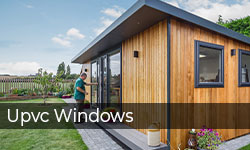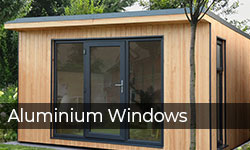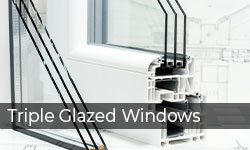
Triple Glazed Windows
Triple Glazed Windows
Aluminium frames undergo rigorous extrusion mechanisms, with the profiles being welded together to a specific shape. During this process, they are fabricated to minimise the heat transfer of cold elements with thermal break technology. That’s why aluminium windows offer unparalleled security and durability. The innate strength allows for large panes of glass to be held and with the edge of the aluminium frame being as close as 50mm to the glass, you can take advantage of more views.
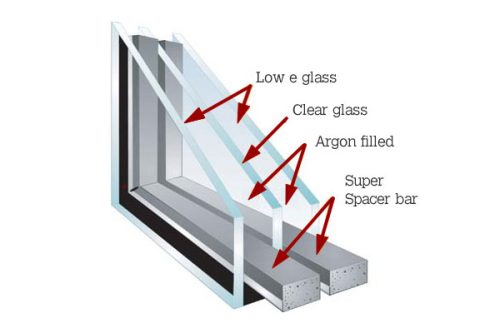
Why triple glazed windows are superior

- They are exceptionally efficient at retaining heat. The extra pane of glass helps to keep heat, generated either by the sun or your central heating system, inside your house. These windows are A+ 21 rated which means that they are able to maximise your home’s energy efficiency.
- Triple-glazed windows block out external noise such as that made by heavy traffic or loud neighbours, helping you to sleep well at night.
- Triple glazed windows are even harder to break than double glazing, making them exceptionally strong and secure.
Features of triple glazing
What makes a good triple glazed window?
The answer is a combination of factors.
Low E coated glass
Without Low E (low emissivity) coated glass, windows will absorb heat from within the home and in turn lose it as it radiates onto the colder outside surface. The Low E glass instead essentially reflects the heat back into the room. It will reduce heat transference significantly and will make a considerable difference when it comes to improving the thermal efficiency of both the window and the overall property.
Low iron glass
The outside panel of glass contains low iron which means that it is crystal clear and so lets more light, and therefore heat, into your home.
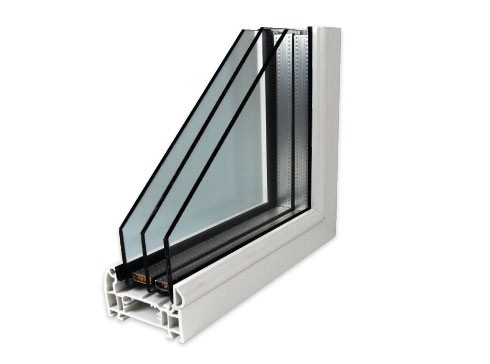
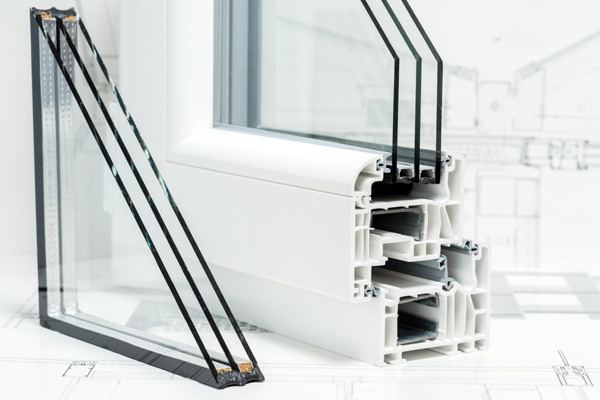
Sealed units
Of course, the triple glazing is hermetically sealed.
The panes are separated by 12 mm and each chamber is filled with Argon gas to improve heat and sound insulation. The frames themselves have:
Spacer bars
The panes of glass in every triple glazed window are separated by warm edge spacer bars made from an insulating plastic that prevents heat loss still further.
Internal beading
An internal glazed bead means that it is even more difficult to remove the glass panes from their frames, giving you even greater security and so peace of mind.
Is it worth getting triple glazing?
- Much of the heat loss in homes occurs through the windows. Triple glazing insulates better than double, lowering energy bills and keeping your home warmer in the winter. The improved heat retention is especially useful if you’re looking to replace single or old, inefficient double glazing.
- Triple glazing is more effective at reducing condensation build-up on your windows.
- Three panes of glass are harder to break than two, making it harder for intruders to make their way through your windows.
- Ever been unable to enjoy a ‘peaceful’ Friday evening because those noisy neighbours of yours just won’t shut up? Well, the extra pane in use will reduce the amount of external noise making its way into your home. This means you can finally enjoy some quiet time.
- Generally, triple glazing costs more than double initially, however it will begin paying for itself over time, with the money it’ll knock off your energy bills.
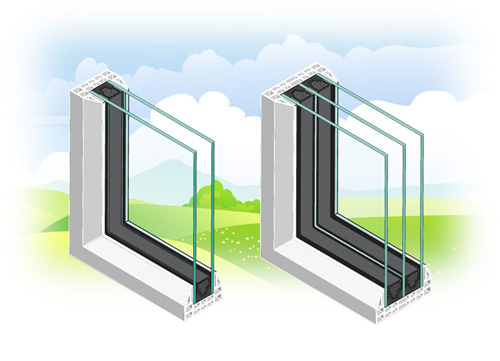
Styles Of Garden Room Windows
Casement windows
Chances are you have casement windows in your house; they are side hinged openers set in a framework with a sill.
Like in your house casement windows are a good option for a garden office. They come in different sizes and styles – plain, with bars etc., and offer a real benefit in that you can easily open them to ventilate the room.
Casement windows also work well in a garden office because they can be positioned over the desk area, giving you a view to gaze out at as you work! The fact that furniture can easily be positioned below and around casement windows maximise the working space. Which can be a problem when choosing floor to ceiling glazing options.
Casement windows are typically found on the more traditional garden office styles, with contemporary garden office designers favouring larger expanses of glass.
Floor to ceiling windows
Floor to ceiling glazing has become a significant trend in garden office design. We can understand why, because it enables a connection of the inside space with the garden. Its this connection with the outdoors which appeals to many garden office owners.
Floor to ceiling windows come in all shapes and sizes and are used in different positions by different suppliers. The common trend is to create whole walls of glazing by mixing large fixed floor to ceiling windows with a set of doors.
Because floor to ceiling glass is usually fitted in one piece, so there are no bars breaking up the visual line. They are normally fixed, i.e. non-opening windows, and this can pose an issue with getting air into the room. There are some days when you just want a window ajar for a little air, but your only option would be to open the door which could be too much!
Garden office designers get around this issue by either designing opening sections in their glazed walls, although they are not keen on this because the framework for an opening window breaks the clean visual line. Or, they include smaller opening windows elsewhere in the building or even opening roof windows.
Wrap around windows
Wrap around glazing is a favourite feature in garden office design, as it creates a real connection of inside-outside space and floods the room with natural light.
Depending on the design of the building the glazing can wrap around two elevations or even three. When the glazing wraps around the building like this the structure of the roof appears to float on the glazing – rest assured a lot of engineering goes into ensuring that the weight of the building isn’t going through the glass!
Wrap around glazing takes two forms; the most common is floor to ceiling fixed glass panels which are mixed in with door systems to create glazed walls. The other option is desk height wrap-around glazing.
Desk height wrap-around glazing is a clever option as it maximises the internal space for office furniture, e.g. desks, shelving etc., but also maximises the glazing in the area you are working. Creating a cockpit-like setup. Which makes you feel, as you are sitting at your desk, that you are part of the garden.
Desk height wrap-around glazing tends to be a combination of fixed glazed panels and top hung (awning) windows which allow you to control the ventilation in the room.
Narrow rectangular windows
Narrow rectangular windows are also known as lozenge or letterbox windows. We are seeing them used in garden office design more and more. Rectangular windows tend to be used with other styles of glazing such as floor to ceiling windows and are useful as high-level glazing or desk height glazing.
Although some rectangular windows are fixed, i.e. they don’t open. Most examples we have seen are top hung awning windows. This is very useful, particularly when combined with large expanses of fixed glazing as they are easy to open allowing you to control the air flow in the building.
Cathedral windows
Pitched roof garden office designs open up the possibility of including high-level glazing in your design. High-level glazing floods your room with natural light.
With dual pitched garden offices the gable ends can be glazed to great effect. By combining long windows with glazing in the gable end, a cathedral style window can be created.
Porthole windows
A couple of traditional style garden office suppliers offer the option of round windows, often called portholes they resemble the windows on a boat. These round windows can be positioned at standard window height, but are more often positioned in the gable end of the building creating high-level glazing.
Porthole windows come in both fixed, non-opening options and opening windows which are a good ventilation source.
Cathedral windows
Pitched roof garden office designs open up the possibility of including high-level glazing in your design. High-level glazing floods your room with natural light.
With dual pitched garden offices the gable ends can be glazed to great effect. By combining long windows with glazing in the gable end, a cathedral style window can be created.
Roof windows
You’re not limited to just placing windows in the walls of your garden office; the roof can provide a source of good light and an extra ventilation point.
There are lots of different styles of roof window used in garden office design, the most common is the opening roof window like those you’ll find used in loft conversions. This type of window used in a pitched roof design can flood the room with natural light, and they are easy to open. Extras such as remote controls, rain sensors to close the windows and blinds can be easily ordered.
On flat roof garden offices roof lanterns are often used, they can be dome-shaped or four-sided pyramid units. Some designs have opening vents; others are fixed units.






